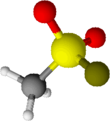Methanesulfonyl fluoride
| |||
| Names | |||
|---|---|---|---|
| Preferred IUPAC name
Methanesulfonyl fluoride[1] | |||
| Other names
Fumette, Mesyl fluoride
| |||
| Identifiers | |||
3D model (
JSmol ) |
|||
| Abbreviations | MSF | ||
| ChemSpider | |||
ECHA InfoCard
|
100.008.358 | ||
| EC Number |
| ||
| MeSH | methanesulfonyl+fluoride | ||
PubChem CID
|
|||
RTECS number
|
| ||
| UNII | |||
| UN number | UN3389 | ||
CompTox Dashboard (EPA)
|
|||
| |||
| |||
| Properties | |||
| CH3FO2S | |||
| Molar mass | 98.09 g·mol−1 | ||
| Appearance | liquid | ||
| Odor | pungent | ||
| Density | 1.427 g/mL[3] | ||
| Boiling point | 123 to 124 °C (253 to 255 °F; 396 to 397 K)[3] | ||
| Reacts | |||
Refractive index (nD)
|
1.360 [2] | ||
| Hazards | |||
| Occupational safety and health (OHS/OSH): | |||
Main hazards
|
Corrosive Highly toxic | ||
| GHS labelling: | |||
 
| |||
| H300, H314, H330 | |||
| P301+P310, P303+P361+P353, P304+P340, P305+P351+P338, P320, P330, P405, P501 | |||
| Related compounds | |||
Other anions
|
Methanesulfonyl chloride | ||
Except where otherwise noted, data are given for materials in their standard state (at 25 °C [77 °F], 100 kPa).
| |||
Methanesulfonyl fluoride (MSF) has long been known to be a potent inhibitor of acetylcholinesterase (AChE), the enzyme that regulates acetylcholine, an important neurotransmitter in both the central and peripheral nervous systems.[4][5]
Technical and physical properties
MSF is a clear, colorless to yellowish
Methanesulfonyl fluoride has a pungent odor. It undergoes decomposition on heating to liberate additional toxic fumes of
Synthesis
A typical synthesis is to treat methanesulfonyl chloride with potassium fluoride or potassium bifluoride in water and then steam distill the product out.[10]
Therapeutic study
Animal studies have shown that MSF-induced inhibition of AChE is highly selective for the brain when it is studied in vivo. MSF is an irreversible inhibitor of AChE and its inhibition of AChE is only overcome by de novo synthesis of new AChE in each tissue. The recovery of AChE activity in the brain is less than one-tenth as rapid as AChE recovery in the gastrointestinal system, allowing very high accumulated AChE inhibition in the brain with clinically insignificant AChE inhibition in peripheral tissues.[11][12] The high selectivity of MSF for inhibition in the brain has suggested that it could be used as a treatment for dementia of the Alzheimer type,[11] that it is effective in reducing the persistent cognitive deficit after stroke,[13] and it is highly effective in reducing normal age-related memory impairment, making aged rats perform as well as younger rats.[14]
Methanesulfonyl fluoride has been tested successfully in three human clinical trials as a treatment for Alzheimer's dementia. Two Phase I clinical trials testing for safety of MSF in humans at the doses proposed for treating dementia have shown that it is well tolerated and relatively free of the side effects of nausea, vomiting, and diarrhea that are produced by the current cholinesterase inhibitors used for the treatment of Alzheimer's dementia.[15] Furthermore, a Phase II, clinical trial testing both the safety and the efficacy of MSF found that it was well tolerated in the aged patients, and it was highly effective in reducing the symptoms of Alzheimer's dementia.[15] US Patent has been issued for the use of MSF for the treatment of dementia.[16]
References
- ^ "methanesulfonyl fluoride - Compound Summary (CID 11207)". PubChem. Retrieved July 25, 2012.
- ^ a b c "H53460 Methanesulfonyl fluoride, 98%". Archived from the original on January 16, 2013. Retrieved July 25, 2012.
- ^ a b c "METHANESULFONYL FLUORIDE". chembook. Retrieved July 25, 2012.
- PMID 13119739.
- PMID 14033211.
- ^ PMID 14033210.
- PMID 532785.
- ^ MSDS, Fisher Scientific
- ISBN 978-0-8155-1166-3. Retrieved 25 July 2012.
- .
- ^ ISBN 978-1-4612-9283-8.
- PMID 23116458.
- PMID 15748872.
- PMID 8367021.
- ^ PMID 10192638.
- ^ US 5798392, Moss; Donald Eugene, "Sulfonyl fluorides for the treatment of Alzheimer's disease", issued 1998-08-25


